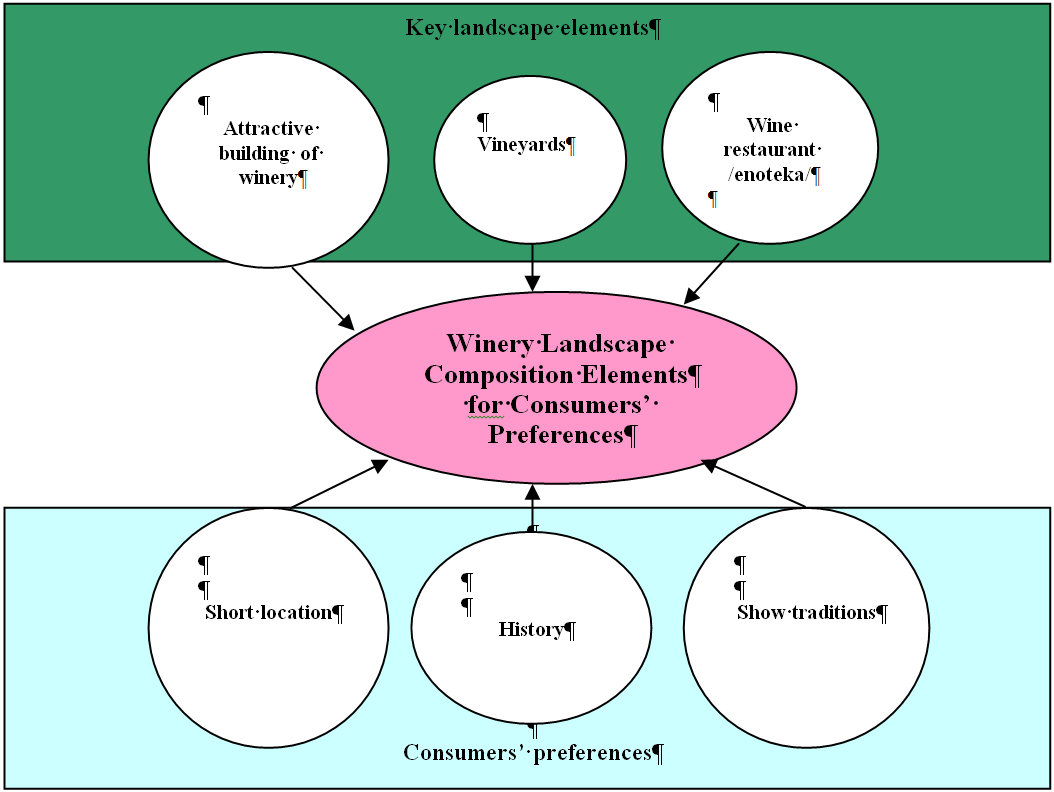Objective
The purpose of ad-hoc study is to analyse the landscape composition as a value to consumers of wine tourism product.
Methodology
The methodology followed in this paper can be divided into five distinct parts. First, using geographic information systems, the area of study was classified into inhomogeneous landscape compositions. Second, we took photos that were intended to cover the most important landscape elements in context of wine tourism. Third, we assessed the perception of the landscape as a value in consumers’ perspectives. Fourth, we evaluated the attractiveness of the landscape elements present in each image using nominal variables. Finally, we build a model of attractive wine tourism product to consumers' perceptions of visual quality of the landscape.
In a first step 6 areas with vineyards and winery buildings were identified through spatial analysis (GIS). In a second step photos were used in the survey, which included natural and man-made elements. There were 9 panels, each containing 5 photos, and 48 participants ranked the best one of each panel. Each participant evaluate landscape elements using 4 scale grade from the own point of view. More than 45 photos were taken in the study area between April and May 2013, with the aim of capturing the most relevant features of the landscape. The photos were taken using a Nikon D60 digital camera on clear days. The place of shooting was the area around of identified wineries. The result is a wide variety of pictures represent various landscape composition, with most the elements that were included in the visual quality expert panel analysis. A selection of photos of different landscape compositions was made for presentation to observers on 9 panels, with 5 compositions on each panel. The observers choose one composition from each panel.
Survey of consumers’ preferences: Participants in five focus groups determined which elements and also which composition of the landscape like them in the context of wine tourism. In the conducted experiment, 48 participants take part. All of them are visitors at wineries in the Pazardjik region. The evaluation of landscape composition is accomplished with the aid of participants of focus group. They provide an assessment of how much the appearance of an element of the landscape in the proposed product has value for them. Focus groups were conducted in two stages. The first is a questionnaire in which each participant assesses individual landscape attributes whether they meet his expectations related with sense of wine tourism. Thus, assess the importance of each attribute. Participants form a summary assessment that gives an idea of preferred combinations of attributes (landscape composition). In the second stage are displayed images representing different combinations of the landscape attributes. Participants expressed their opinion what is the most attractive to them in a sense of wine tourism. Responses of each participant shall be reconciled with the questionnaires. Thus verifying the results sought. Gives an answer to the question of which elements of landscape stimulate the demand of wine tourism and how wineries use them.
Results
Figure 1 shows the results of the expert evaluation showing the most preferred landscape composition by respondents. The percentages show the distribution of images of landscape compositions based on the highest aggregate score from consumer’s perspective. Image 3 (building of winery + hill) is the most liked landscape composition about 35% of the respondents. The next level of attractiveness of landscape composition is vineyard + mountain (see image number 2), following by landscape composition - building of winery + village (see image 4). Another preferred composition of landscape is captured in image number 3 (building of winery + history). The rest images of landscape compositions are not identified as attractive to respondents. Other images (image 6 and 7) of landscape compositions are not defined as attractive to the respondents such as, combination of vineyards and traditions or even just vineyards.

Based on the results we build a model of attractive wine tourism product to consumers' perceptions of visual quality of the landscape. The model includes key landscape elements and consumers’preferences for valuable landscape composition. Figure 2 represents the model.

The main elements included at the model are:
Short location of the winery in the composition of the landscape. Placement selection of the complex in a particular landscape, must comply with the following factors - open, expansive and diverse landscape that captures the eye (picturesque landscape). Attractive building of winery. The architecture of the winery, should enable them to maximize view of the surrounding landscape. Another factor that must be taken into account in the construction of the complex is to provide a quiet atmosphere. To meet this condition, the complex must be located away from the traffic, but at the same time the access to it has to be easy. Enoteka is another important element of the product is the creation of conditions for a tasting of local wines. This requires an enoteca and a special place for wine sales in the complex. In wine production is necessary to combine local traditions and history. This ensures uniqueness of the wines offered in the complex. The wineries must possess vineyards. From consumers’ point of view vaneyards create spiritual experience and sense of place.
References
Nikolov, D., P. Borisov, T. Radev (2012). Policy Intervention Effects on Landscape Management. 132nd Seminar of the EAAE "Is transition in European agriculture really over? New dimensions and challenges of transition and post-transition process of agriculture and food sectors in the European Union and EU acceding and neighboring countries". October 25-27, 2012, Skopje, Macedonia.
Nikolov, D., P. Borisov, T. Radev (2013). Landscape as a driver for competitiveness of Pazarjik district in Bulgaria. 2nd AIEAA Conference – Between Crisis and Development: which Role for the Bio-Economy Parma, 6-7 June 2013.
Responsible partner/person
Dimitre Nikolov, Petar Borisov, Teodor Radev
Agricultural University Plovdiv
Mendeleev Str. 12, Plovdiv, Bulgaria
